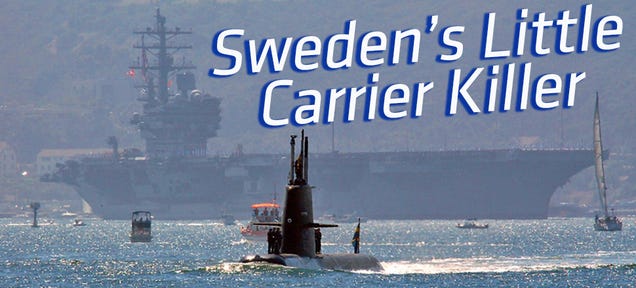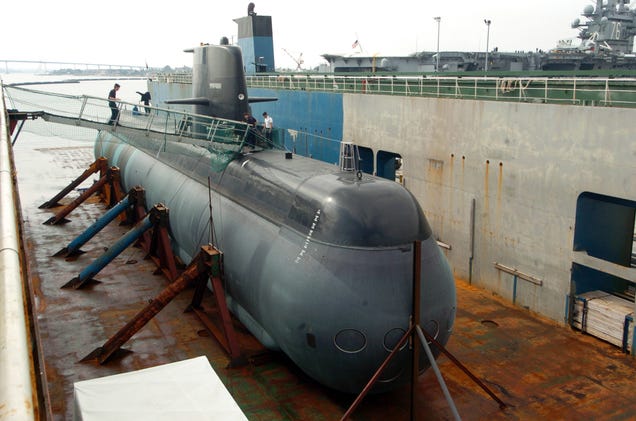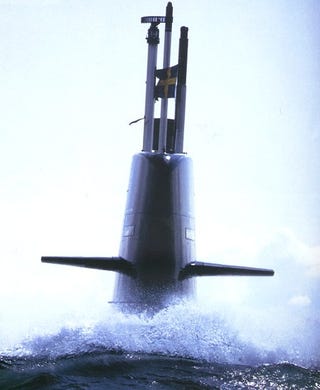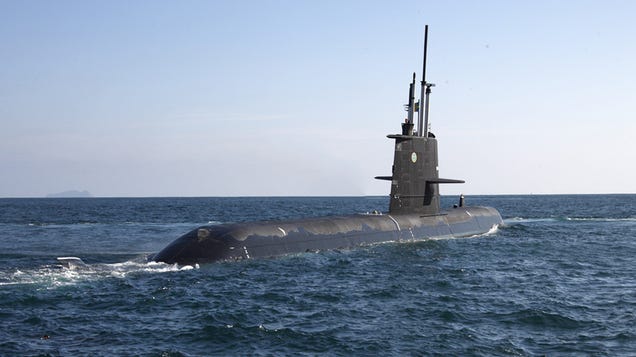SvenSvensonov
PROFESSIONAL

- Joined
- Oct 15, 2014
- Messages
- 1,617
- Reaction score
- 207
- Country
- Location

We have been glued all week to the sub saga off the coast of Sweden, where six days in Swedish forces have only now called off their search for an elusive sub hiding in the waters off Stockholm. Yet what nobody has mentioned is just how deadly and capable Sweden's own subs are, and there are few better weapons for catching a sub than another sub.
Sweden's submarine force is relatively tiny, just five boats make up the entire inventory, but those five vessels are extremely stealthy and lethal, especially their three Gotland Class diesel-electric submarines. Entering service in the mid 1990s, the 1600 ton displacement Gotland Class was the first operational Air Independent Propulsion (AIP) submarines in the world, which gave them the previously unprecedented operational ability (for non-nuclear submarines at least) to stay submerged for weeks at a time.

With performance once only within the realm of much more complex, expensive, larger and louder nuclear submarines, AIP technology is revolutionizing the accessibility of long diving and silent running submarine capabilities. There are now multiple AIP concepts out there, with fuel cell based systems being a popular choice as of late. Yet legendary ship builder Kockums was the first to market with their AIP system which utilizes advanced batteries that are charged by 75kw generators. These generators are run by a pair of diesel and liquid oxygen fueled Stirling Engines. The result of this unique, yet remarkably simple system is two weeks of submerged air independent propulsion while traveling at about 6mph. Oh, and Kockums' AIP system is virtually silent, even in comparison to multi-billion dollar nuclear powered boats that still have to pump high-volumes coolant to their reactors.
The Gotland Class can also act like a traditional diesel-electric submarine and run on its standard diesel engines while surfaced or snorkeling. It can also run on battery power alone, where it can hit speeds up to 20 knots submerged. The capability to patrol silently for weeks on AIP, run un-stealthily on its standard diesel engines, or rocket through the water for shorter periods on silent battery power alone, give the Gotland Class a certain tactical agility that is very hard for the enemy to predict.

The Gotland Class measures 200 feet in length and are just over 20 feet in width. They are crewed with an incredibly lean compliment of 24 sailors and officers. These submariners are put through exhaustive psychological and physiological testing to make sure they can handle life aboard the small vessel.
As for weapons, these capable little submarines feature four 533mm torpedo tubes that can fire the time-tested and heavy hitting Bofors Underwater Systems Type 613torpedoes. The "Torpedo 613" is an incredibly powerful anti surface ship weapon, packing a range of about 12 miles, an engagement speed of 40kts and a massive high-explosive warhead weighing in at nearly about 650lbs. A newer updated multi-role heavy torpedo that can be used against both surface and submarine targets is also carried by the Gotland Class, called the 'Torpedo 2000.' This cutting edge weapon has double the range of the Torpedo 613, although less raw explosive power. Sixteen 533mm class torpedoes can be carried at any given time about the HMS Gotland and her two sisters ships.
The Gotland Class is also equipped with a pair of 400mm tubes that are used by the maneuverable Saab Bofors Underwater Systems Type 43X2 lightweight multi-role torpedo. Each tube can hold two of these versatile and compact torpedoes at one time.
What makes this small and quiet sub even more deadly is her combat management system which is truly state of the art and is said to feature an incredibly user friendly interface. During a single attack, the system can guide multiple torpedoes at once, which can result in more than a mission kill for even very large naval combatants like aircraft carriers, with each torpedo striking in a different section of the hull if ordered to do so.

Her sensor suite is provided by Atlas Elektronik and is also extremely capable and fully integrated into the boat's combat management system. A bow mounted cylindrical sonar array, intercept array, conformal passive sonar arrays on her sides, electronic service measures and a radar detection, classification and homing suite made by Thales and known as 'Manta' rounds out the ship's primary sensor fit. The whole combat system interface is constantly being upgraded and new sensors can be added with relative ease as needed.
Mine warfare is also a major part of the Gotland Class's mission. They can deploy Saab Bofors Underwater Systems stand-off self-deployed Mine 42, which can travel autonomously for miles before descending to the sea floor. There it can lie in wait for a target ship or submarine to pass by, and will then activate and prosecute an attack autonomously. This unpredictable and 'smart' mine can also detonate or deactivate itself after a certain period of time. Additionally, the Gotland can carry up to 48 traditional mines externally.
Maneuverability was a key factor in the Gotland Class design and this manifests itself in the boat's "X" shaped tailplane structure. This unique design provides four independent maneuvering surfaces at its stern and is tied to another two planes mounted on the boat's sail. These control surfaces, combined with the sub's advanced and highly automated control system, allows for incredibly tight turns, dives and ascensions even in very close quarters, such as in shallow littoral environments. Due to the boat's size, automation and maneuverability, theGotland Class has been described as the F-16 Viper of the undersea combat world.

The Gotland Class hull was specifically designed for high efficiency while producing a very low noise signature and it is coated with sonar deadening materials. She also carries a series of electromagnets to counteract her magnetic signature and can short circuit very low frequency fields on command. Her sail is also covered with radar absorbent material and designers are said to have gone through great lengths masking the boat's infrared signature even when surfaced. On her interior, every piece of machinery is mounted on a series of rubber acoustic and vibration deadening buffers so as to minimize the accumulation of noise emanating from the craft's various mechanical subsystems.
As the Gotland and her two sister ships, the HMS Uppland and HMS Halland, matured into highly capable operational attack and reconnaissance boats, they began taking part in international exercises. In 2000 they traveled to the Mediterranean for a large multi-national training event where they astonished participating countries by remaining virtually undetected throughout the exercise while actively surveying and shadowing opposing forces. In some cases they sat undetected for long periods of time while visibly observing submarine hunting activities on the decks of 'enemy' frigates and destroyers.
The Gotland Class boats then participated in open-ocean exercises in the Atlantic where they trounced much more advanced Spanish, French and US players, including a French nuclear fast attack sub and the American Los Angeles Class SSN, the USS Houston.
Other exercises soon followed and the little Gotland Class boats continued to be a very lethal force to reckon with. By the mid 2000s, other countries were starting to field or develop AIP capable diesel-electric submarines, including Russia and especially China. Since the US Navy had retired its last diesel-electric (non-AIP) attack submarine in 1990, the USS Blueback (now a local resident here at Oregon's Museum of Science & Industry) there was no indigenous force to practice hunting down diesel-electric subs, yet alone ones with advanced AIP capabilities. Thus the US Navy went to Sweden hat in hand in hopes of leasing one of their ninja-like Gotland Class boats, and its crew, for a year. The Swedish sub would be playing the adversary to America's massive constellation of anti-submarine surface combatants, helicopters, fixed wing aircraft, and especially nuclear submarines. The Swedes granted this request and the Gotlandwas shipped to San Diego aboard a mobile drydock.
By mid summer of 2005 the Gotland arrived in San Diego and war games immediately commenced. Apparently the Navy got more than they were bargaining for when it came to finding and engaging the stealthy little sub. The Gotland virtually "sunk" many US nuclear fast attack subs, destoryers, frigates, cruisers and even made it into the 'red zone' beyond the last ring of anti-submarine defenses within a carrier strike group. Although it was rumored she got many simulated shots off on various US super-carriers, one large-scale training exercise in particular with the then brand new USS Ronald Reagan ended with the little sub making multiple attack runs on the super-carrier, before slithering away without ever being detected.
One contact of mine within the anti-submarine community said that the Gotland was the single biggest eye opener of their career, the little Swedish sub was "so silent it literally did not exist to our sensors." Apparently the Swedish crew knew exactly how to employ her strengths to devastating effects as that same contact described the sub as "a vastly demoralizing capability that changed the priorities within the surface and sub-surface warfare communities."
Once the first year of the lease ran out, the Navy quickly arranged another year on the contract to sort through tactics as to how to deal with this proliferating and unassuming yet deadly threat. It wasn't until mid 2007 that the Gotland finally loaded up on its mobile drydock and headed back to its home on the Baltic Sea.

Fast forward the better part of a decade and AIP submarines, some more advanced than theGotland Class, are prowling the seas and littorals around the globe. Seeing as these boats cost millions, instead of billions of dollars, they are potentially a fairly cheap way of shattering shipping in key global waterways, or even stalking coastlines for soft targets such as ships in port, not to mention having the potential of taking on some of most capable anti-submarine forces in the world.
After fighting multiple land wars in the deserts of Iraq and mountains of Afghanistan for a decade and half, America's anti submarine warfare capability had atrophied. Today there is apush within the Navy to make it a high priority once again, especially after the lessons learned during the Gotland's time as a opposing force aggressor and the rise of China's nuclear ballistic submarine force. New tactics and technologies are quietly being applied to combat these cheap but potentially disastrous underwater stalkers, although it seems like it will still be some time until the Navy has the threat under any sort of control.
The success and proliferation of these relatively inexpensive but highly capable diesel-electric AIP boats also invites the question- why doesn't America have any? Considering that we are facing a submarine shortage as even the cost-cutting Virginia Class nuclear fast attack submarines are just too expensive to build and operate ($2.7B per Virginia Class SSN) in numbers large enough to meet tasking demands, buying some advanced AIP diesels-electric boats off the shelf may be a suitable solution for filling at least a portion of this looming 'submarine gap.'

The German-built and Israeli operated improved Dolphin Class submarine, based on the successful Type 209/212 boats, cost about half a billion dollars each, meaning we could purchase 5 for every Virginia Class SSN. Even with American modifications, at say $750M per boat, that equals 3.6 boats per every Virginia Class SSN.
For forward deployed operations, buying a few dozen of these incredibly capable AIP boats may not only make sense monetarily and quantitatively, to up our hull numbers of attack and surveillance subs, but it could also drastically increase our presence in key hot spots around the globe. Because they are not nuclear, America could forward deploy a large portion of such a fleet to friendly nations.

Southeast Asia and the increasingly volatile South China Sea, comes to mind as an especially ideal place to base even a portion of a theoretical American Dolphin Class or enhanced Gotland Class sub force. Currently we have a Littoral Combat Ship deployed to Singapore, and Japan and Northern Australia may be future ports for these and other ships. Pairing the LCS's capabilities with an AIP capable diesel electric submarine makes incredible sense, especially if that Littoral Combat Ship were equipped with the anti-submarine warfare mission package. They could fight and spy as a team, and the LCS could act as a bunker and supply ship for its super efficient AIP capable submarine partner. This would drastically increase the LCS's utility and effectiveness, and it would give these lightly armed and ambiguous ships a clear purpose and mission set to work from.
The incredible capability of Sweden's Gotland Class subs, especially in 'brown water' littoral environments, also brings us back to the peculiar search for a mystery sub just miles from Stockholm. Although Sweden lacks a large anti-submarine force, and especially an aerial contingent, they do have their incredible Gotland Class subs, yet nobody has even mentioned their existence during this whole ordeal. Sometimes the very best way to catch a robber is by asking another robber where they would strike next and how they would go about doing so, and in this case, if there truly was a foreign submarine in Sweden's territorial midst, catching it with another submarine may very well make the most sense.
Seeing as the HMS Gotland can sneak its way through many miles and layers of anti-submarine defenses surrounding a US super-carrier, entering literally the most defended and highly surveyed area in the world, one would think sneaking up on a Russian midget sub would be well within Sweden's stealthy sub's repertoire.
Then again, maybe they actually have been hard at work over the last six days of the search as they still would have at least another week before they would even have to come up for air. The same can be said for Russia's new AIP submarine designs, the active Lada Class and the upcoming Amur Class. And that is just the problem, not only are AIP boats so hard to detect, but they are also relatively cheap, and will give friendly and enemy states alike a resurgent clandestine subsurface capability.
With this in mind, I doubt that Sweden's wild goose chase will be the last one of its kind for some time. As this technology spreads we will probably see more and more news about "foreign objects"suspected to be operating closely off friendly shores.

From Sweden Has A Sub That's So Deadly The US Navy Hired It To Play Bad Guy
*My comments;
While more modern designs such as the type 039, Soryu, and Lada (export designation Amur) are much improved, even the tiny Gotland can pose a massive threat to even the most advanced of navies. It would be wrong to assume we didn't learn anything from our lease of the Gotlands though. Also, the article has a few mistakes, but I hope you can overlook them.
@Nihonjin1051 @AMDR @C130 @Peter C @LeveragedBuyout - thought you guys might be interested in a little naval history.
Last edited:












